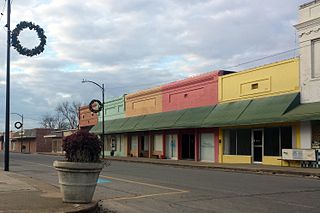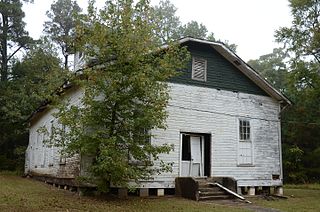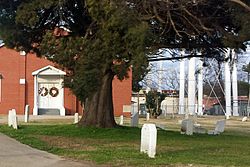
Lake Village is a city in and the county seat of Chicot County, Arkansas, United States. The population was 2,575 at the 2010 census. It is located in the Arkansas Delta. Lake Village is named for its location on Lake Chicot, an oxbow lake formed by the Mississippi River.

Cuba is a town on the western border of Allegany County, New York, United States. The village of Cuba lies within its borders. The federally recognized tribe of Seneca Native Americans has a reservation on the western town line. As of the 2020 Census, the total population was 3,154.
Crane Hill is an unincorporated community in Cullman County, Alabama, United States, located in the southwestern portion of the county. The community of Crane Hill traces its history back to 1806, when the first settlers recorded their land titles. The area is named after the Sandhill Crane who fished the streams and roosted on a hill located just north of Mt. Zion Road.

St. Louis Street Missionary Baptist Church is a historic African American church in Mobile, Alabama. It was added to the National Register of Historic Places on October 8, 1976, due to its architectural and historic significance.

The First Missionary Baptist Church is a Gothic Revival style church located at 701 South Gaines Street in Little Rock, Arkansas. It was built in 1882, and added to the National Register of Historic Places in 1983. It is home to one of the oldest African-American congregations in the state, first organized in 1845.

Second Baptist Church is a historic church building in the village of Mechanicsburg, Ohio, United States. Constructed in the mid-19th century, it is the oldest church in the village, and it has been named a historic site.

The Antioch Missionary Baptist Church Cemetery is located at 500 North McKinney Road in Sherrill, Arkansas, behind the Antioch Missionary Baptist Church. The earliest graves contain the remains of emancipated slaves, originally enslaved on the Good Hope Plantation in South Carolina, but moved to Jefferson County, Arkansas in 1860. Reverenced Lewis Mazique, a leader in the community, was the earliest documented burial, in 1885. The cemetery continues to be used today, although infrequently.

The Oak Grove Missionary Baptist Church is a historic church on Hempstead County Route 16, about 3 miles (4.8 km) south of the small town of Blevins, Arkansas. It is a single-story wood-frame structure, with a Jerkinhead roof, and a steeple topped by a hip roof. It was built in 1942, using in part materials recycled from an 1870 church which was dismantled due to the establishment of the Southwestern Proving Ground in 1940. The church serves an African-American congregation that was, prior to its relocation, in a community that was originally named for, and supported by, Arkansas Senator James Kimbrough Jones. The church property includes a small wood-frame Sunday school building, constructed about the same time as the church, and a cemetery.

Mount Zion Missionary Baptist Church is a historic church at 409 S. Main Street in Brinkley, Arkansas. It is a red brick building with front facing gable roof, and a pair of square towers flanking the main structure. The left tower is slightly taller, an intentional element of the design that was maintained when one tower had to be shortened by removing of its belfry. The towers are joined by a three-bay porch sheltering the building's main entrance. The church was built in 1909 for an African-American congregation established in 1886, and has been a major cultural focus for that community since.
The New Light Missionary Baptist Church was a historic church at 522 Arkansas Street in Helena, Arkansas. It was a two-story wood-frame brick and masonry structure, built in 1917 for an African-American congregation organized in 1894. Its Gothic Revival design bore some resemblance to Helena's Centennial Baptist Church, but this building's architect is not known. Its main facade had a single tall gable, with a three-story tower at the southwest corner. A pair of entrances on the first level were topped by three lancet-style windows in the gable, the center one larger than those flanking it. The interior was simply decorated.

The McCanaan Missionary Baptist Church is an active church in Sardis, Georgia. It serves members in Burke County, Georgia and Screven County, Georgia. Together with its cemetery, it was listed on the National Register of Historic Places in 2001 as McCanaan Missionary Baptist Church and Cemetery.
Samuel L. Woolfolk, sometimes spelled Woodfork, was a member of the Arkansas Legislature in 1891. He represented Jefferson County, Arkansas. He was included in a photo montage of African American state legislators serving in Arkansas in 1891 published in The Freeman newspaper in Indianapolis.

Elias Camp Morris was an American minister, politician, and businessman. Born a slave, Morris attended seminary then preached at Centennial Baptist Church in Helena, Arkansas. He rose to prominence among black Baptists, leading the Foreign Missionary Convention. When the convention merged with two other black Baptist organizations in 1895, Morris became the president of the resulting National Baptist Convention, leading it for twenty-seven years. Morris was also active in the Arkansas Republican Party, serving as a national delegate three times, and co-founded the Arkansas Baptist College.

Rutledge, Florida is an unincorporated community in central Alachua County, Florida. The community was established for formerly enslaved persons during Reconstruction by the Freedmen's Bureau. The First Morning Star Missionary Baptist Church and the Greater Liberty Hill United Methodist Church, both founded in the 19th century, continue to serve the community. The Greater Liberty Hill church is the site of the Liberty Hill Schoolhouse, which is on the National Register of Historic Places. The Rutledge Community Cemetery, formerly called Union Cemetery of Rutledge, is under the stewardship of the Second Morning Star Missionary Baptist Church. The center of the community was located about five miles west of Gainesville, Florida in the 19th century. As of 2021 it extends from just west of the Gainesville city limits to I-75. A post office was established in 1886, and closed in 1905. In 1888 the community had three stores and a boarding house. It was on the planned route of the Gainesville, Tallahassee and Western Railroad, which was never built.
Oakland, Union Parish, Louisiana is a former community in northern Union Parish, Louisiana, United States. About one mile south of the Arkansas state line, it is 18 miles (29 km) north of Farmerville and 10 miles (16 km) northwest of Marion. It was also known as Union Cross Roads and Springhill or Spring Hill.













